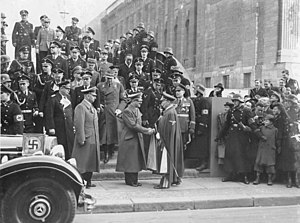SS-Begleitkommando des Führers
| SS-Begleitkommando des Führers; Führerbegleitkommando | |
|---|---|

Führerbegleitkommando and other uniformed SS men providing security for Hitler in February 1939
|
|
| Active | 29 February 1932 – 30 April 1945 |
| Country |
|
| Allegiance | Axis |
| Branch |
|
| Role | Bodyguards |
SS-Begleitkommando des Führers ("SS Escort Command of the Führer"), later known as the Führerbegleitkommando (Führer Escort Command; FBK) was originally an eight-man SS squad formed from a twelve-man security squad (known as the SS-Begleitkommando) tasked with protecting the life of Adolf Hitler during the early 1930s. It was expanded and remained responsible for Hitler's personal protection until 30 April 1945.
The SS-Begleitkommando was formed on 29 February 1932 to provide general protection to Hitler and other party functionaries. Twelve SS members were selected by Sepp Dietrich to present to Hitler. From the twelve, a smaller eight-man team called the SS-Begleitkommando des Führers was chosen to protect Hitler as he travelled around Germany. Their first appearance was when they accompanied Hitler during the election campaign trips in 1932. They served around the clock protecting Hitler.
In the spring of 1934, the Führerschutzkommando (FSK) replaced the SS-Begleitkommando des Führers for Hitler's overall protection throughout Germany. The small SS-Begleitkommando des Führers unit continued to provide personal security for Hitler. The FSK was also responsible for general security measures, preventive measures, and prosecution of assassination attempts. The Führerschutzkommando was officially renamed the Reichssicherheitsdienst (Reich Security Service; RSD) on 1 August 1935. The RSD and the SS-Begleitkommando cooperated with the Ordnungspolizei (uniformed order police), Gestapo, and other agencies to provide the inner security requirements, whereas outer protection was handled by general SS units.
Later the SS-Begleitkommando was expanded and became known as the Führerbegleitkommando (Führer Escort Command; FBK). By 1937, the unit had grown to 37 members. The FBK continued under separate command and to provide the close, personal security for Hitler, alone. The additional members for the FBK were drawn from 1st SS Panzer Division Leibstandarte SS Adolf Hitler (LSSAH). Hitler used them for guard duty, but also as orderlies, valets, waiters, and couriers. Although the FBK was administratively under the control of the LSSAH, they received their orders directly from Hitler and in the last years from his chief adjutant, Julius Schaub.
...
Wikipedia
